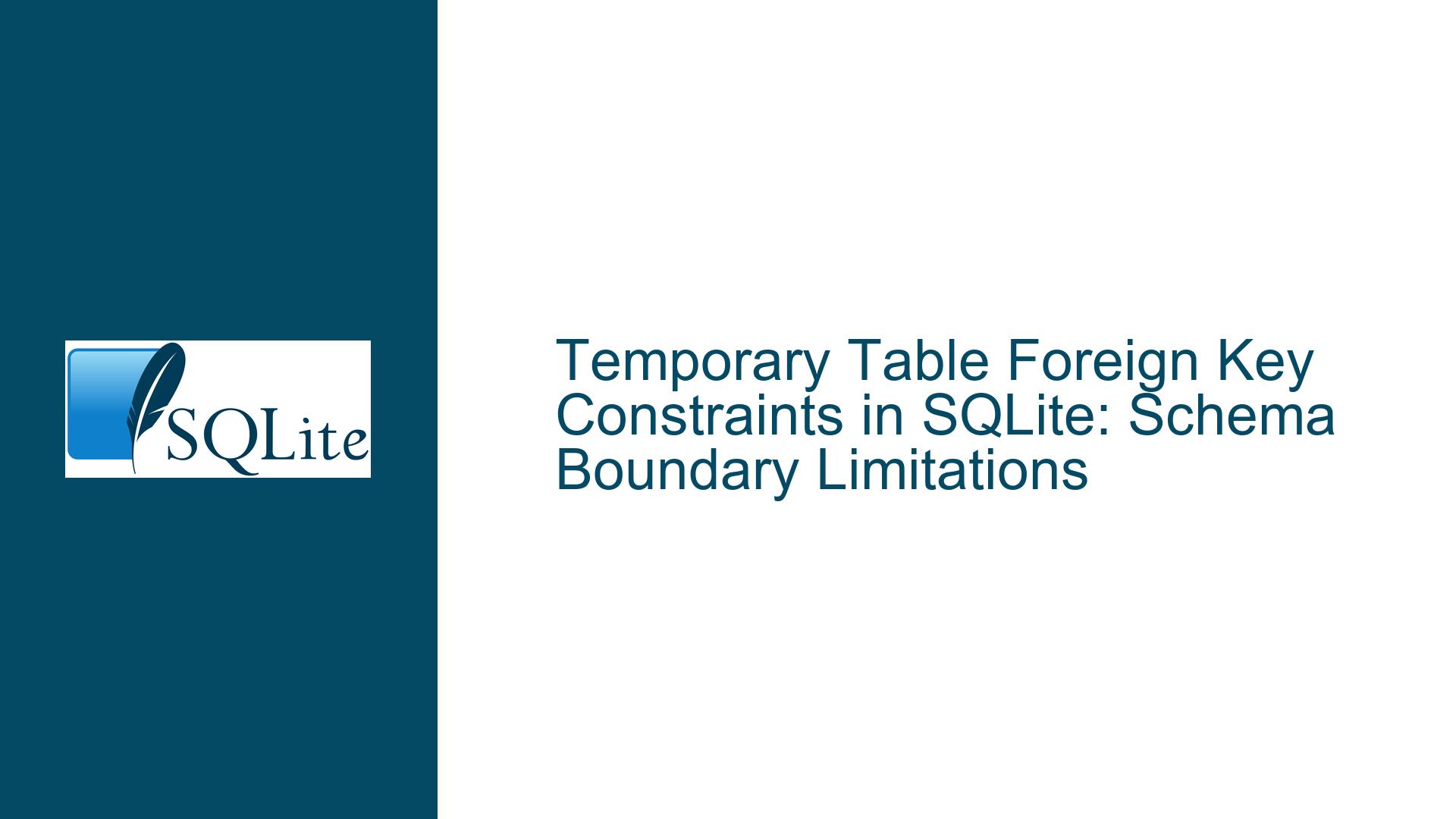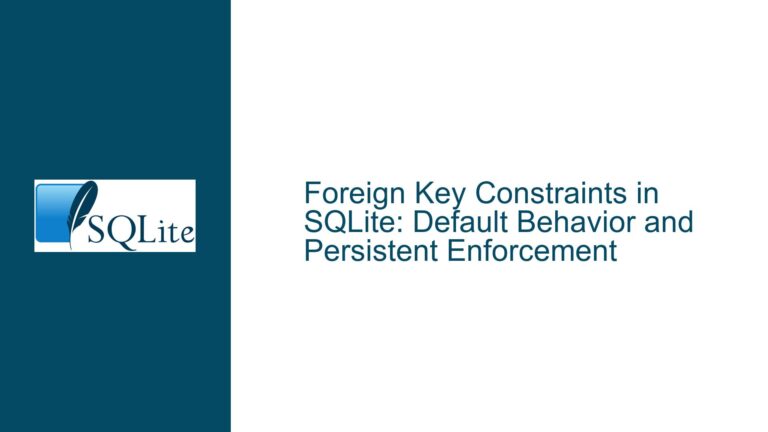Temporary Table Foreign Key Constraints in SQLite: Schema Boundary Limitations
Issue Overview: Temporary Tables and Foreign Key Constraints Across Schemas
In SQLite, the creation of temporary tables with foreign key constraints referencing persistent tables in the main schema can lead to unexpected errors. This issue arises due to SQLite’s enforcement of schema boundaries, which restricts foreign key references from crossing schema boundaries. Specifically, when a temporary table attempts to reference a persistent table in the main schema, SQLite fails to resolve the reference, resulting in an error such as "no such table: temp.parent."
The core of the problem lies in SQLite’s schema resolution mechanism. SQLite maintains separate namespaces for different schemas, including the main schema (where persistent tables reside) and the temporary schema (where temporary tables reside). Foreign key constraints are resolved within the schema of the table containing the REFERENCES clause. This means that a temporary table in the "temp" schema cannot directly reference a table in the "main" schema, even if the table names are unqualified and appear to shadow each other in other contexts.
For example, consider the following scenario: A persistent table named parent is created in the main schema, and a temporary table named my_temptable is created in the temp schema with a foreign key constraint referencing parent. When an INSERT operation is attempted on my_temptable, SQLite fails to resolve the reference to parent because it looks for parent within the temp schema, not the main schema. This behavior is consistent with SQLite’s design but can be counterintuitive for users expecting temporary tables to seamlessly interact with persistent tables.
Possible Causes: Schema Boundary Enforcement and Foreign Key Resolution
The root cause of this issue is SQLite’s strict enforcement of schema boundaries for foreign key constraints. SQLite’s documentation explicitly states that foreign keys may not cross schema boundaries. This means that a table in one schema cannot reference a table in another schema using foreign key constraints. The schema boundary restriction applies even when the table names are unqualified, as SQLite resolves unqualified table names within the schema of the table containing the REFERENCES clause.
In the context of temporary tables, this restriction manifests when a temporary table in the temp schema attempts to reference a persistent table in the main schema. SQLite’s schema resolution mechanism does not automatically fall back to the main schema when resolving references in the temp schema. Instead, it strictly adheres to the schema boundary, leading to the "no such table" error.
Another contributing factor is the way SQLite handles unqualified table names in different contexts. While unqualified table names in queries or DML statements (e.g., SELECT, INSERT) are resolved by searching the temp schema first and then the main schema, this behavior does not extend to foreign key constraints. Foreign key constraints are resolved strictly within the schema of the table containing the REFERENCES clause, without falling back to other schemas.
This behavior can be particularly confusing for users who are familiar with SQLite’s handling of unqualified table names in other contexts. For example, when querying a table with an unqualified name, SQLite first searches the temp schema and then the main schema. This shadowing behavior creates the expectation that temporary tables can seamlessly interact with persistent tables, but this expectation does not hold for foreign key constraints.
Troubleshooting Steps, Solutions & Fixes: Workarounds and Best Practices
To address the issue of temporary tables with foreign key constraints referencing persistent tables, several workarounds and best practices can be employed. These solutions aim to either circumvent the schema boundary restriction or restructure the database design to avoid the need for cross-schema foreign key constraints.
1. Use Fully Qualified Table Names in Foreign Key Constraints
One potential workaround is to use fully qualified table names in foreign key constraints. However, this approach is not supported in SQLite, as foreign key constraints cannot reference tables in other schemas. Attempting to use a fully qualified table name (e.g., main.parent) in a foreign key constraint will result in a syntax error or an unresolved reference.
2. Restructure the Database Design to Avoid Cross-Schema Foreign Keys
A more robust solution is to restructure the database design to avoid the need for cross-schema foreign key constraints. This can be achieved by either moving the referenced table to the same schema as the temporary table or by using alternative mechanisms to enforce referential integrity.
For example, if the temporary table my_temptable needs to reference the persistent table parent, consider creating a copy of parent in the temp schema. This approach ensures that the foreign key constraint is resolved within the same schema, avoiding the schema boundary restriction. However, this solution requires additional steps to synchronize the data between the main schema and the temp schema, which may not be feasible in all scenarios.
3. Use Application-Level Referential Integrity Checks
Another approach is to enforce referential integrity at the application level rather than relying on foreign key constraints. This involves performing explicit checks in the application code to ensure that the values inserted into the temporary table exist in the referenced persistent table. While this approach provides greater flexibility, it also places the burden of maintaining referential integrity on the application, which can be error-prone and less efficient than database-enforced constraints.
4. Leverage Triggers for Cross-Schema Referential Integrity
Triggers can be used to enforce referential integrity across schemas, albeit with some limitations. For example, a BEFORE INSERT trigger on the temporary table can check whether the referenced value exists in the persistent table and raise an error if the check fails. This approach mimics the behavior of foreign key constraints but requires careful implementation to ensure correctness and performance.
5. Avoid Temporary Tables for Referential Integrity Scenarios
In some cases, the best solution may be to avoid using temporary tables altogether for scenarios requiring referential integrity with persistent tables. Instead, consider using persistent tables with appropriate cleanup mechanisms or in-memory databases for temporary data storage. This approach simplifies the database design and avoids the complexities associated with schema boundaries and foreign key constraints.
6. Use Views or Common Table Expressions (CTEs) for Temporary Data
If the use of temporary tables is primarily for intermediate data processing, consider using views or common table expressions (CTEs) instead. Views and CTEs provide a way to encapsulate complex queries and intermediate results without the need for physical tables. While they do not support foreign key constraints, they can be used in conjunction with application-level checks or triggers to enforce referential integrity.
7. Evaluate the Use of Alternative Databases
If the limitations of SQLite’s schema boundary enforcement are a significant impediment, consider evaluating alternative databases that support cross-schema foreign key constraints. Lightweight databases such as PostgreSQL or MySQL offer more flexible schema management and foreign key enforcement, which may better suit the requirements of the application. However, this approach involves trade-offs in terms of complexity, performance, and deployment considerations.
8. Monitor SQLite Updates and Community Contributions
SQLite is an actively maintained project, and future updates may introduce enhancements or changes to the handling of schema boundaries and foreign key constraints. Monitoring SQLite’s release notes and community contributions can provide insights into potential improvements or workarounds for the issue. Additionally, engaging with the SQLite community through forums or mailing lists can yield valuable advice and alternative solutions from experienced users and developers.
Conclusion
The issue of temporary tables with foreign key constraints referencing persistent tables in SQLite stems from the database’s enforcement of schema boundaries. While this behavior is consistent with SQLite’s design, it can be counterintuitive for users expecting seamless interaction between temporary and persistent tables. By understanding the underlying causes and exploring the available workarounds and best practices, developers can effectively address this limitation and design robust database solutions that meet their application’s requirements. Whether through restructuring the database design, leveraging application-level checks, or exploring alternative databases, there are multiple pathways to achieving referential integrity and efficient data management in SQLite.





